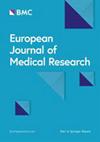A comparative analysis of postoperative morbidity and alveolar bone regeneration following surgical extraction of ımpacted lower third molar teeth using piezosurgery and conventional ınstruments: a split-mouth clinical ınvestigation
IF 3.4
3区 医学
Q2 MEDICINE, RESEARCH & EXPERIMENTAL
引用次数: 0
Abstract
This randomized, split-mouth study aimed to compare postoperative complications following the surgical extraction of impacted lower third molars using piezosurgery versus conventional rotary instruments. Twenty-one patients, aged 18–35 years, with bilaterally and symmetrically impacted lower third molars, were randomly assigned to undergo extraction using piezosurgery on one side and conventional rotary instruments on the other. The piezosurgery method required a longer operation time. However, it resulted in quicker resolution of postoperative swelling by the 7th day compared to the conventional method, where swelling persisted longer. Mandibular angle-tragus measurements were significantly higher with the conventional method on the 1st, 3rd, and 7th postoperative days. Although mouth opening decreased significantly after piezosurgery, it returned to preoperative levels by the 7th day, outperforming the conventional method. Postoperative pain was notably higher with the conventional method during the first four days but showed no significant difference from the 5th day onward. Alveolar bone healing was significantly better with piezosurgery at the 3rd and 6th months. Temporary paresthesia occurred in one patient from the conventional group, resolving within four weeks. Neither method resulted in alveolar osteitis. Within the study's limitations, piezosurgery demonstrated a reduction in postoperative discomfort, suggesting its advantage in enhancing patient recovery following lower third molar extractions. Piezosurgery, when used appropriately, can reduce postoperative complications compared to conventional methods. Clinicians should be aware of its indications, benefits, and potential challenges. Trial registration This study was registered as a clinical trial to the ClinicalTrials.gov, and the registration ID is NCT06262841 ( https://clinicaltrials.gov/study/NCT06262841 ).使用压电外科手术和传统器械拔除受撞击的下第三磨牙后的术后发病率和牙槽骨再生的比较分析:分口临床调查
这项随机分口研究旨在比较使用压电外科器械和传统旋转器械手术拔除撞击性下第三磨牙后的术后并发症。21 名患者年龄在 18-35 岁之间,患有双侧对称的撞击性下第三磨牙,他们被随机分配到一侧接受压电手术拔牙,另一侧接受传统旋转器械拔牙。压电手术法需要更长的手术时间。不过,与肿胀持续时间较长的传统方法相比,压电手术法能更快地在术后第 7 天消除肿胀。传统方法在术后第 1 天、第 3 天和第 7 天的下颌角-ragus 测量值明显更高。虽然压电手术后张口度明显下降,但在术后第 7 天恢复到术前水平,优于传统方法。传统方法的术后疼痛感在术后前四天明显较高,但从术后第五天开始就没有明显差异了。压电手术在第 3 个月和第 6 个月的牙槽骨愈合效果明显更好。传统方法组的一名患者出现暂时性麻痹,但在四周内缓解。两种方法均未导致牙槽骨炎。在该研究的局限性范围内,压电手术减少了术后不适,这表明它在促进下第三磨牙拔除术后患者恢复方面具有优势。与传统方法相比,压电手术如果使用得当,可以减少术后并发症。临床医生应了解其适应症、优点和潜在挑战。试验注册 本研究已作为临床试验在ClinicalTrials.gov上注册,注册编号为NCT06262841 ( https://clinicaltrials.gov/study/NCT06262841 )。
本文章由计算机程序翻译,如有差异,请以英文原文为准。
求助全文
约1分钟内获得全文
求助全文
来源期刊

European Journal of Medical Research
医学-医学:研究与实验
CiteScore
3.20
自引率
0.00%
发文量
247
审稿时长
>12 weeks
期刊介绍:
European Journal of Medical Research publishes translational and clinical research of international interest across all medical disciplines, enabling clinicians and other researchers to learn about developments and innovations within these disciplines and across the boundaries between disciplines. The journal publishes high quality research and reviews and aims to ensure that the results of all well-conducted research are published, regardless of their outcome.
 求助内容:
求助内容: 应助结果提醒方式:
应助结果提醒方式:


